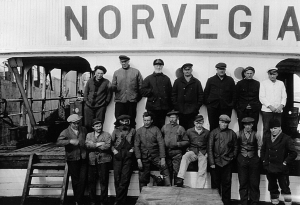Did you know that the Norwegian vessel Norvegia sailed all around Antarctica in 1927 to 1931?
The Norwegian whaling pioneer Lars Christensen sent out nine expeditions to Antarctica between 1926 and 1945. Four are known as the Norvegia expeditions. During these missions, scientific investigations were carried out and unknown territories were charted; this helped ensure that Norway now has sovereign territories in the southern hemisphere.
 The Norvegia expedition of (1930–31). Photo: Jens Eggvin / Norwegian Polar Institute
The Norvegia expedition of (1930–31). Photo: Jens Eggvin / Norwegian Polar Institute
The sealer Vesleper was purchased in 1927 and renamed Norvegia. The first Norvegia expedition (1927–28) rediscovered Bouvetøya and led to that island officially becoming a Norwegian dependent territory in 1930. The expedition did extensive meteorological and oceanographic studies, as well as research on krill.
The next expedition with Norvegia (1928–29) was the first to go ashore on Peter I Øy, which had been discovered in 1821. The island was declared Norwegian territory and a hut was built there. The operations extended from Bouvetøya to the sea west of the South Shetland Islands, south to 71°11’S and west to 140°49’W.
The third Norvegia expedition (1929–30) was led by Hjalmar Riiser-Larsen. They went first to Bouvetøya, where they built two depot huts, one at Kapp Circoncision and another, smaller one on Larsøya. In addition, large parts of the island were mapped and aerial photographs were taken. After that, Norvegia headed for Antarctica. On 22 December 1929, Riiser-Larsen and Lützow-Holm landed their planes in Enderby Land and raised the Norwegian flag. Riiser-Larsen’s and Lützow-Holm’s flights over Dronning Maud Land also led to the discovery and mapping of Kronprins Olav Kyst and Kronprinsesse Märtha Kyst (the Crown Prince Olav and Crown Princess Märtha Coasts). The expedition visited the area from south of South Georgia at 37°W to Dronning Maud Land and the ocean at 56°E.
The fourth and last expedition with Norvegia (1930–31) was initially under Gunnar Isachsen’s command, and then under Hjalmar Riiser-Larsen. The main tasks of the expedition during their circumnavigation of the Antarctic continent were to look for whales and carry out oceanographic, meteorological, and biological studies. They did a series of soundings around the entire Southern Ocean: many underwater banks and shallows were found and meteorological and oceanographic data were collected.
Riiser-Larsen’s aim was to complete the aerial mapping that had begun the previous year. The surveying work led to the discovery of Prinsesse Ragnhild Kyst during the expedition. After Riiser-Larsen had finished his aerial mapping and gone home, Norvegia went in search of Pagoda Rock, an island that had been reported in 1845, but the search was fruitless. The vessel stopped at Bouvetøya before turning northward to Cape Town. On 15 May 1931, Norvegia anchored in Sandefjord and the event was suitably celebrated.